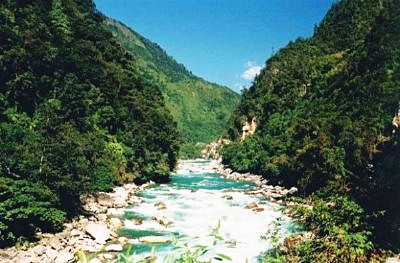
Dimaluo Valley in Gongshan County, Nujiang

Attraction Overview
Dimaluo valley is located in Dimaluo village(迪麻洛村), Pengdang township(捧当乡), 29 kilometers away from the county town. In the middle of the valley there are Congni Churches(从妮教堂) and more than 100-year-old Baihanluo Church(白汉洛教堂).
Attraction Type: Valley
Chinese Name: 迪麻洛峡谷(Pinyin: Dimaluoxiagu)
Recommended Visiting Time: 1 Day
Open Hours: All the Day
Admission Fee: Free
Location: Dimaluo village, Gongshan Autonomous County of Dulong Nationality, Nujiang Lisu Autonomous Prefecture, Yunnan
📍 Location
Dimaluo Village is located in Pongdang Township, Gongshan County, Nujiang Prefecture, Yunnan Province, bordering Deqin County to the east, nestled between the Biluoxue Mountain and Gaoligong Mountain gorges.
Elevation: Varies significantly between 1,700–2,800 meters
Geography: A karst alpine terrain
The village name in the Nu language means “Watery Ravine”
🌦️ Climate & Vegetation
Cool and humid climate with an annual average temperature of 12°C
Annual rainfall: Approx. 1,350 mm
Forest coverage: Over 80%
Rich in wild ferns, alpine rhododendrons, and other high-altitude flora
🏘️ Village Composition
Dimaluo administers 12 village groups, including Gekedang, Butuo, and Longpo.
As of 2020, the population was approximately 2,202, predominantly Tibetan and Nu ethnicities
🌄 II. Natural Resources & Industries
🏞️ Natural Attractions
Alu Laka Alpine Pasture
Altitude: 2,800–3,300 meters
In summer, vast fern meadows resemble green carpets; in winter, snow-covered panoramas emerge
Offers eastward views of Biluoxue Mountain and westward views of the Nujiang Gorge
Ideal for photography and camping
Hidden Trekking Routes
Key stop along the Biluoxue Mountain crossing
Path winds through virgin forest, suspension bridges, and mountain streams
Some sections require mule caravan support
🐑 Specialty Products
Animal Husbandry
One of the largest pastoral areas in Nujiang Prefecture
Known for high-quality yak butter
Livestock includes Dulong cattle and Tibetan sheep
Medicinal Herbs
Large-scale cultivation of Mu Xiang (Costus root) (4,000 mu), Chishao (Red Peony Root), and Cordyceps
Home to three cooperative breeding bases
🕊️ III. Culture & Intangible Heritage
⛪ Religious Heritage
Baihanluo Church
Hidden deep in the mountains, retaining medieval-style Catholic rituals
Features local dialect Bible readings and hymns
Free lodging available with advance notice
🎨 Traditional Crafts
Wooden homes, traditional weaving, and Tibetan wood carving techniques are well preserved
Visitors may see Nu women weaving or artisans working on Tibetan-style carvings
🏕️ IV. Recommended Travel Experiences
✅ Immersive Activities
Pasture Adventures
Alu Laka Tent Camp offers panoramic views of sunrise above a sea of clouds, alpine picnics, and horse-feeding or wood-chopping experiences
Golden fern seas during late summer create a magical, dreamlike setting
Expedition Trekking
Hike from Dimaluo Gorge to Biluoxue Mountain
Requires professional guides; avoid during rainy season due to landslide risk
Cultural Immersion
On Thursdays, Qingmatang hamlet hosts a market trading in yak butter and medicinal herbs
Visitors can also attend church services
🧭 V. Travel Information & Tips
| Category | Details |
|---|---|
| 🚗 Transportation | Self-drive: Navigate to “Dimaluo Village” via De-Gong Highway, ~28 km from county center (off-road vehicle recommended) |
| Bus: From Gongshan County, take a rural bus to Pongdang Township, then switch to local vehicles | |
| 🛏️ Accommodation | Basic village homestays (approx. 50–100 RMB/night), free church lodging (advance request needed), or Alu Laka tent glamping |
| 📅 Best Season to Visit | May–October (avoid snow), November for golden ferns; avoid July–August due to heavy rain |
| ⚠️ Tips |
Some trekking sections lack safety infrastructure—guides and anti-slip gear are essential
Landslides possible in rainy season—exercise caution
Church events require silence and respect for religious customs |
💎 Rural Revitalization Highlights
Since 2024, Dimaluo has launched agro-cultural tourism village projects, completing road paving and traditional housing renovation.
Poverty rate reduced from 55.35% to near zero
Actively developing eco-tourism industries


 7 Days GolfingTour
7 Days GolfingTour
 8 Days Group Tour
8 Days Group Tour
 8 Days Yunnan Tour
8 Days Yunnan Tour
 7 Days Shangri La Hiking
7 Days Shangri La Hiking
 11 Days Yunnan Tour
11 Days Yunnan Tour
 6 Days Yuanyang Terraces
6 Days Yuanyang Terraces
 11 Days Yunnan Tour
11 Days Yunnan Tour
 8 Days South Yunnan
8 Days South Yunnan
 7 Days Tea Tour
7 Days Tea Tour
 8 Days Muslim Tour
8 Days Muslim Tour
 12 Days Self-Driving
12 Days Self-Driving
 4 Days Haba Climbing
4 Days Haba Climbing
 Tiger Leaping Gorge
Tiger Leaping Gorge
 Stone Forest
Stone Forest
 Yunnan-Tibet
Yunnan-Tibet
 Hani Rice Terraces
Hani Rice Terraces
 Kunming
Kunming
 Lijiang
Lijiang
 Shangri-la
Shangri-la
 Dali
Dali
 XishuangBanna
XishuangBanna
 Honghe
Honghe
 Kunming
Kunming
 Lijiang
Lijiang
 Shangri-la
Shangri-la
 Yuanyang Rice Terraces
Yuanyang Rice Terraces
 Nujiang
Nujiang
 XishuangBanna
XishuangBanna
 Spring City Golf
Spring City Golf
 Snow Mountain Golf
Snow Mountain Golf
 Stone Mountain Golf
Stone Mountain Golf












